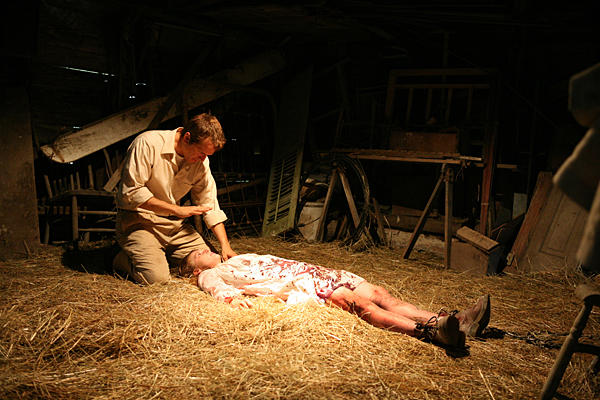Movie review by Greg Carlson
A much better than expected genre outing, “The Last Exorcism” trades William Peter Blatty’s Jesuits for a Louisiana evangelical, but the battlefield is still the body of a young girl, and the thrills are plentiful. Every demonic possession movie made since 1973 owes a bottomless debt to “The Exorcist,” and filmmaker Daniel Stamm pays homage to William Friedkin’s modern classic with taut direction and pacing. “The Last Exorcism” also boasts a sly sense of humor that tempers the increasingly grim events that unfold during the ritual of the title. Additionally, the film borrows heavily from Howard Smith and Sarah Kernochan’s 1972 documentary “Marjoe.”
A nimble script by Huck Botko and Andrew Gurland contextualizes the entire course of action inside a collection of documentary tapes, complete with shaky handheld videography, focus shifts, and numerous “Turn off the camera” moments. No more or less credible than “The Blair Witch Project” “Cloverfield,” and “REC” (as well as English-language remake “Quarantine”), the gimmick of creepy or unsettling found footage has developed into a stylistic cottage industry within the horror narrative. The technique can simulate realism where none exists, but “The Last Exorcism” errs in its liberal application of Nathan Barr’s standard-issue, emotion-manipulating musical score, an addition that invalidates the “authenticity” of the experience.
Because the bulk of the story hinges on a delicate balance between reason and the supernatural, the film’s ending might divide viewer opinion. One of the charms of the “The Last Exorcism” is the constant tease between earthly explanations for the horrors visited upon Nell Sweetzer and the possibility that something truly unaccountable is unfolding on her family’s rural farmstead. Stamm purposefully provides intimations of the former – the insinuation of sexual abuse among other ideas – without skimping on the latter. Performer Ashley Bell, who plays the unfortunate Nell, may not cross the shocking threshold established by Linda Blair, but she does deliver an intensely physical and sympathetic performance.
Some critics have claimed that “The Last Exorcism” mocks religion, or that at the very least, main character Cotton Marcus (Patrick Fabian) ridicules the rubes to whom he preaches every Sunday. This is a facile dismissal, however, as a close viewing shows a man in full acknowledgment of the debt he owes to his family’s occupational tradition. Yes, Marcus freely admits skepticism when it comes to personal belief in bodily possession by demons (and he is more than willing to accept payment for his services), but he also shows genuine compassion for Nell as victim, regardless of the source of her misery. The preacher’s own crisis of faith is also plausibly outlined, moving him away from pure “Elmer Gantry” con artistry.
“The Last Exorcism” is not a great movie, but its refreshing transposition of setting from the well-heeled, Georgetown Roman Catholicism of “The Exorcist” to the swampy revivalism of Baton Rouge and its isolated, rural surroundings holds tight from start to finish. The location photography capitalizes on the readymade eeriness of the Sweetzer clan’s property, and the mock documentary presentation embraces the low-budget aesthetic without making the enterprise feel cheap.
